 |
 |
- Search
| Korean J Fam Med > Volume 38(2); 2017 > Article |
Abstract
Background
Methods
Results
References
Table 1
Characteristics of dyslipidemia patients according to awareness of dyslipidemia
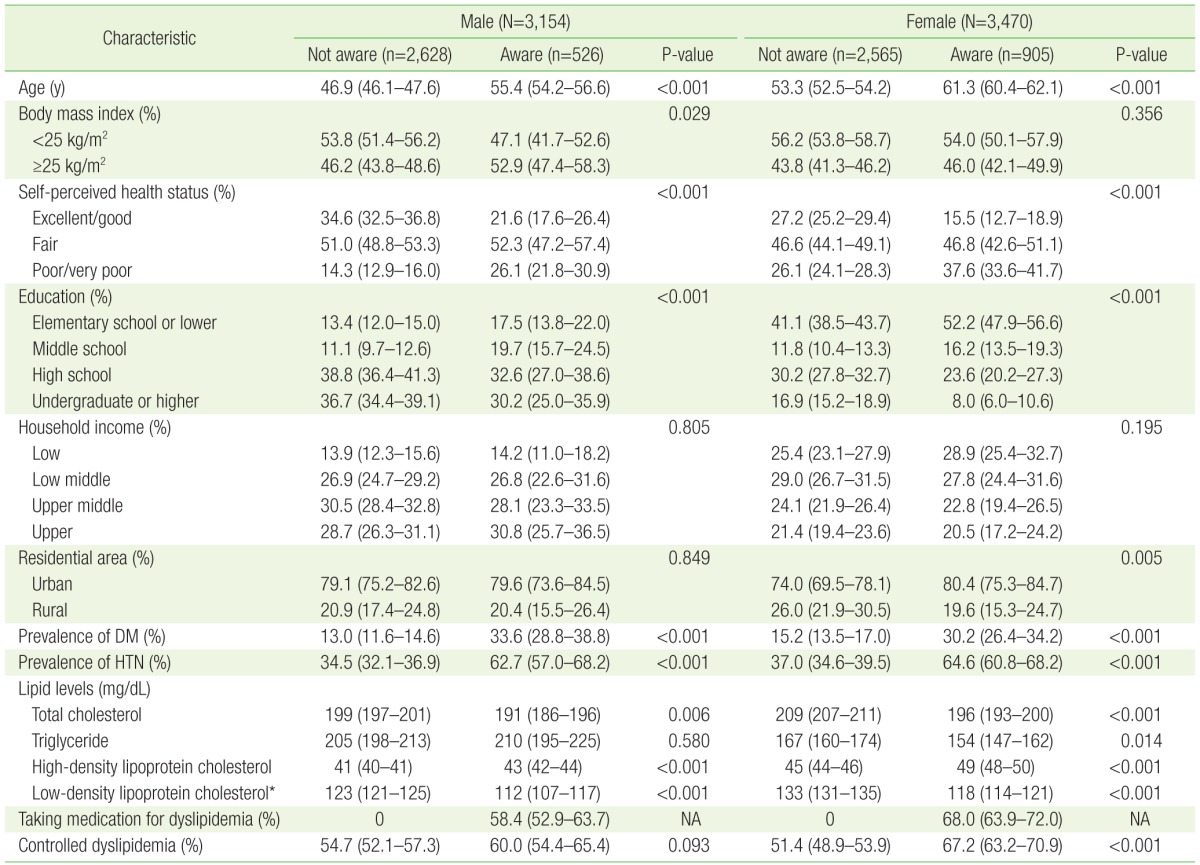
Values are presented as mean (95% confidence interval) for age and lipid levels and % (95% confidence interval) for the remaining variables. All data were weighted to the Korean standard population. Data and P-values were obtained from t-test for continuous variables and chi-square test for categorical variables. Diagnosis of DM: fasting blood glucose ≥126 mg/dL, use of insulin or oral hypoglycemic agents. Diagnosis of HTN: average systolic blood pressure ≥140 mm Hg or diastolic blood pressure ≥90 mm Hg, or taking medication for HTN.
DM, diabetes mellitus; HTN, hypertension; NA, not available.
*Less participants were available for analysis due to measurement methods (male: n=3,076, female: n=3,432).
Table 2
Behavioral risk factors according to awareness of dyslipidemia
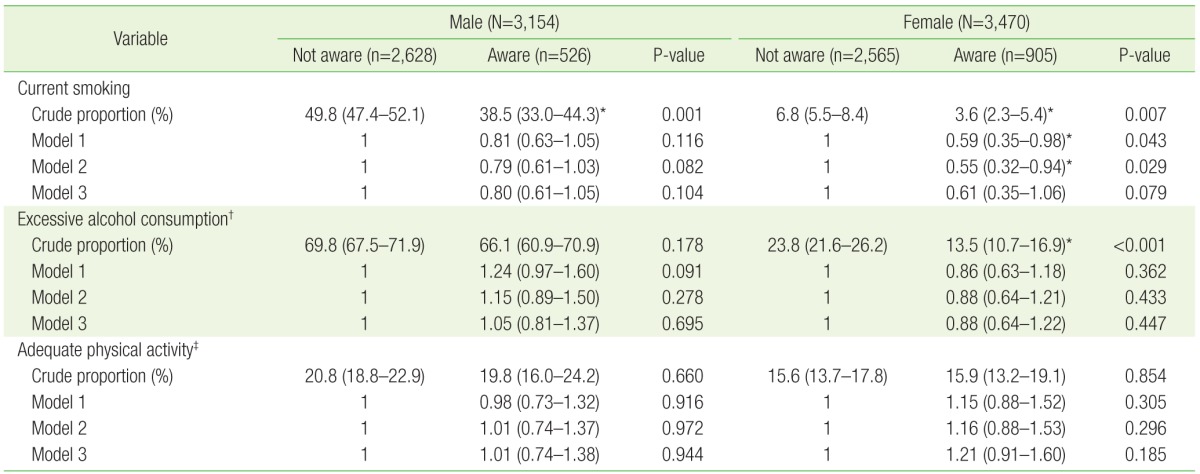
Values are presented as % (95% confidence interval) or adjusted odds ratio (95% confidence interval), weighted to the Korean standard population. Crude proportions with P-values were obtained from chi-square tests, and logistic regression analysis was performed to examine the association between awareness of dyslipidemia and each health behavior with the adjustments specified. Model 1: adjusted for age; model 2: adjusted for age, obesity (BMI ≥25 kg/m2), self-perceived health status, education, residential area, and household income; model 3: adjusted for age, obesity (BMI ≥25 kg/m2), self-perceived health status, education, residential area, household income, prevalence of diabetes, and prevalence of hypertension.
BMI, body mass index.
*Statistically significant, P<0.05. †Excessive alcohol consumption: ≥3 standard drinks on ≥1 occasion in an average week. ‡Adequate physical activity: >150 minutes per week of moderate-intensity activity or >60 minutes per week of vigorous-intensity activity.
Table 3
Nutritional factors according to awareness of dyslipidemia
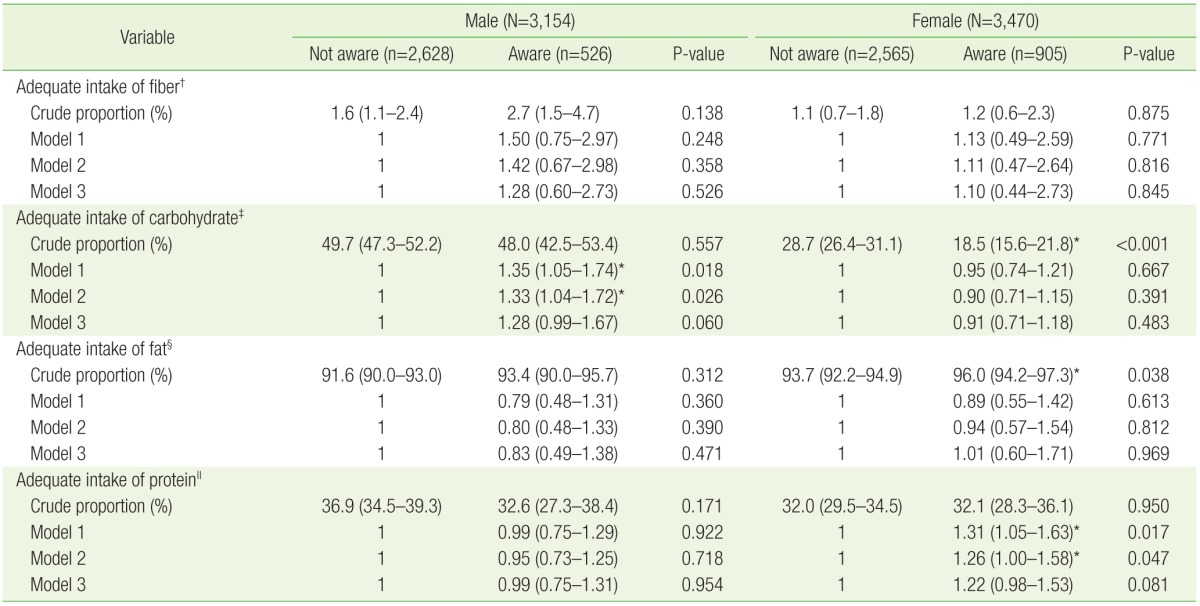
Values are presented as % (95% confidence interval) or adjusted odds ratio (95% confidence interval), weighted to the Korean standard population. Crude proportions with P-values were obtained from chi-square tests, and logistic regression analysis was performed to examine the association between awareness of dyslipidemia and each health behavior with the adjustments specified. Model 1: adjusted for age; model 2: adjusted for age, obesity (BMI ≥25 kg/m2), self-perceived health status, education, residential area, and household income; model 3: adjusted for age, obesity (BMI ≥25 kg/m2), self-perceived health status, education, residential area, household income, prevalence of diabetes, and prevalence of hypertension.
BMI, body mass index.
*Statistically significant, P<0.05. †Adequate intake of fiber: ≥25 g/d. ‡Adequate intake of carbohydrate: <65% of total calories per day. §Adequate intake of fat: <30% of total calories per day. ∥Adequate intake of protein: ≥15% of total calories per day.
Table 4
Subgroup analysis of health behavior according to awareness of dyslipidemia in subjects without hypertension or diabetes mellitus
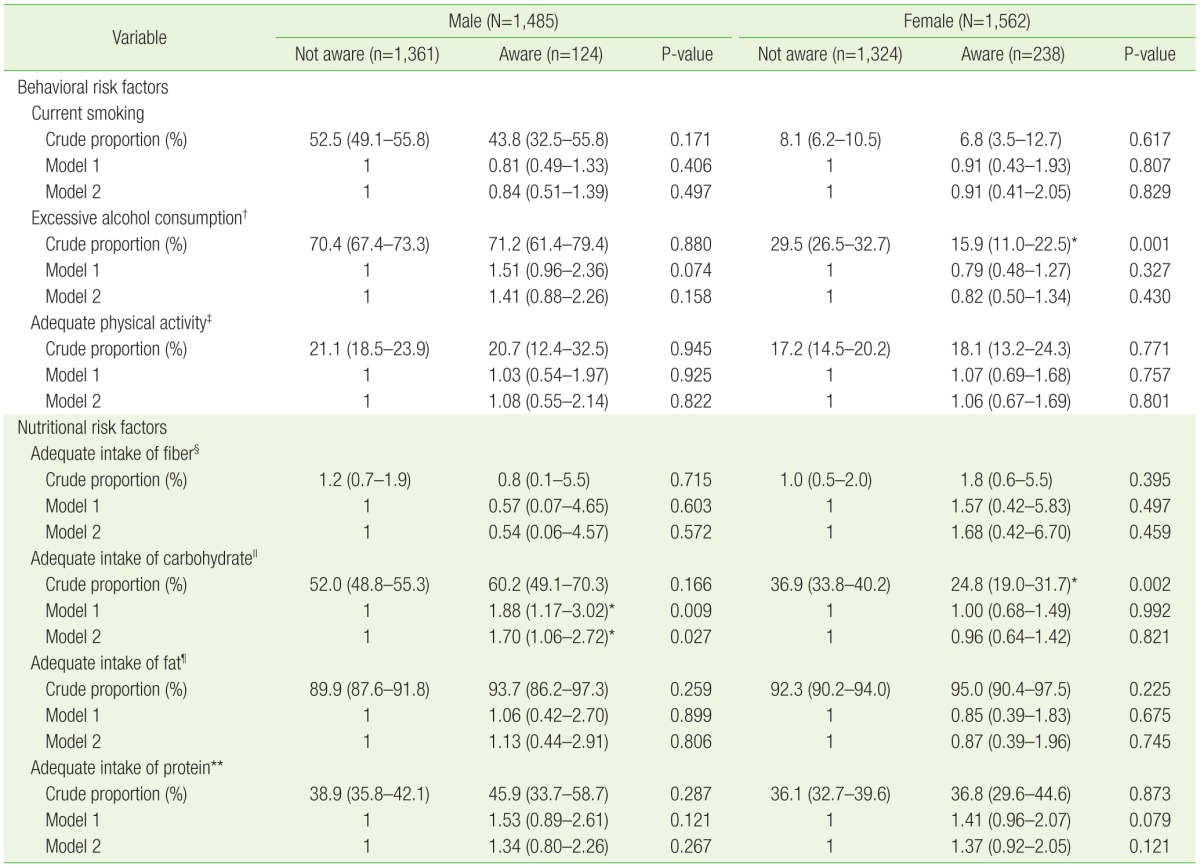
Values are presented as % (95% confidence interval) or adjusted odds ratio (95% confidence interval), weighted to the Korean standard population. Crude proportions with P-values were obtained from chi-square tests, and logistic regression analysis was performed to examine the association between awareness of dyslipidemia and each health behavior with the adjustments specified. Model 1: adjusted for age; model 2: adjusted for age, obesity (body mass index ≥25 kg/m2), self-perceived health status, education, residential area, and household income.
*Statistically significant, P<0.05. †Excessive alcohol consumption: ≥3 standard drinks on ≥1 occasion in an average week. ‡Adequate physical activity: >150 minutes per week of moderate-intensity activity or >60 minutes per week of vigorous-intensity activity. §Adequate intake of fiber: ≥25 g/d. ∥Adequate intake of carbohydrate: <65% of total calories per day. ¶Adequate intake of fat: <30% of total calories per day. **Adequate intake of protein: ≥15% of total calories per day.
Table 5
Subgroup analysis of health behavior according to awareness of dyslipidemia in subjects with diabetes mellitus
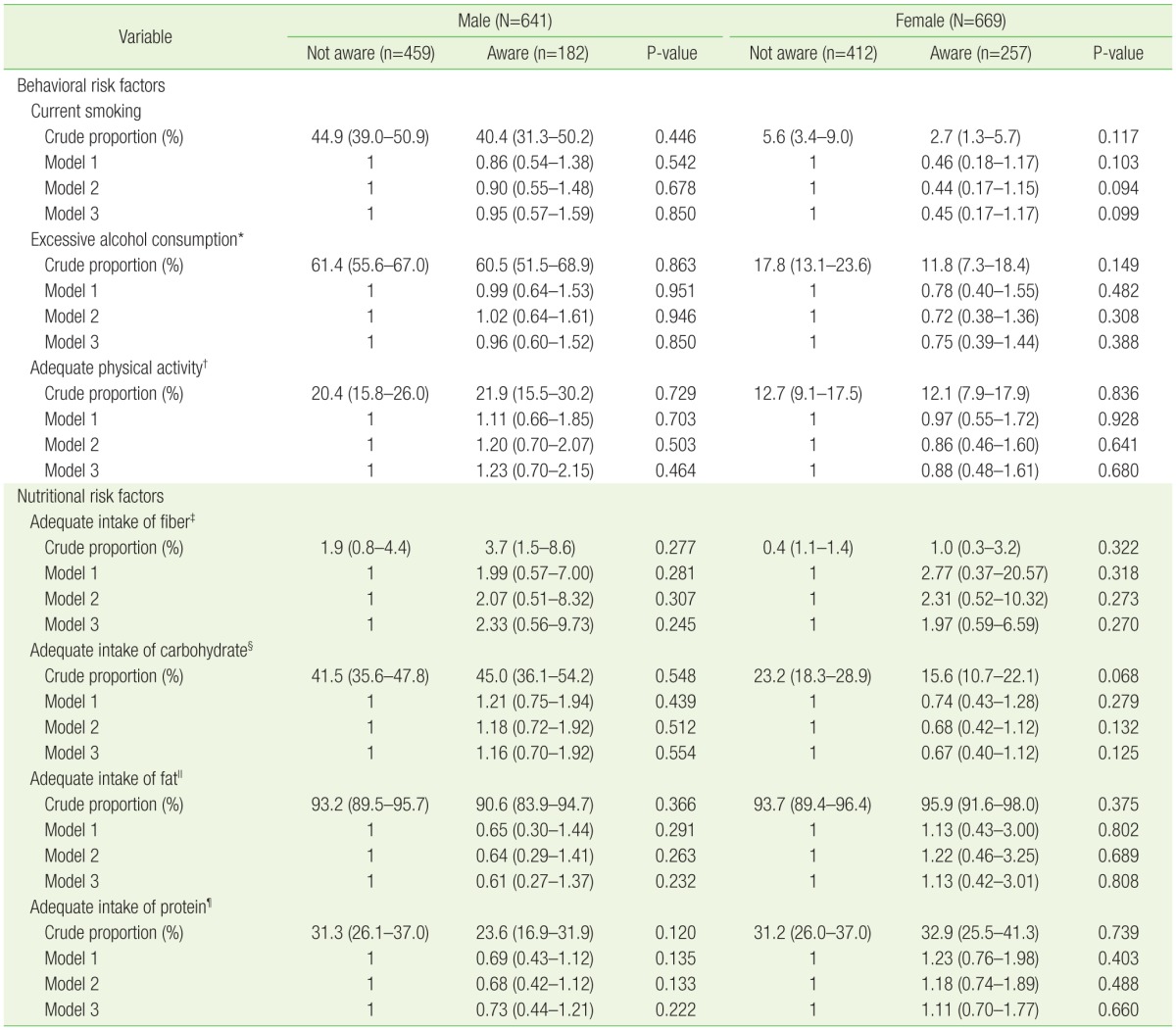
Values are presented as % (confidence interval) or adjusted odds ratio (95% confidence interval), weighted to the Korean standard population. Crude proportions with P-values were obtained from chi-square tests, and logistic regression analysis was performed to examine the association between awareness of dyslipidemia and each health behavior with the adjustments specified. Model 1: adjusted for age; model 2: adjusted for age, obesity (BMI ≥25 kg/m2), self-perceived health status, education, residential area, and household income; model 3: adjusted for age, obesity (BMI ≥25 kg/m2), self-perceived health status, education, residential area, household income, and hypertension.
BMI, body mass index.
*Excessive alcohol consumption: ≥3 standard drinks on ≥1 occasion in an average week. †Adequate physical activity: >150 minutes per week of moderate-intensity activity or >60 minutes per week of vigorous-intensity activity. ‡Adequate intake of fiber: ≥25 g/d. §Adequate intake of carbohydrate: <65% of total calories per day. ∥Adequate intake of fat: <30% of total calories per day. ¶Adequate intake of protein: ≥15% of total calories per day.
Table 6
Subgroup analysis of health behavior according to awareness of dyslipidemia in subjects with hypertension
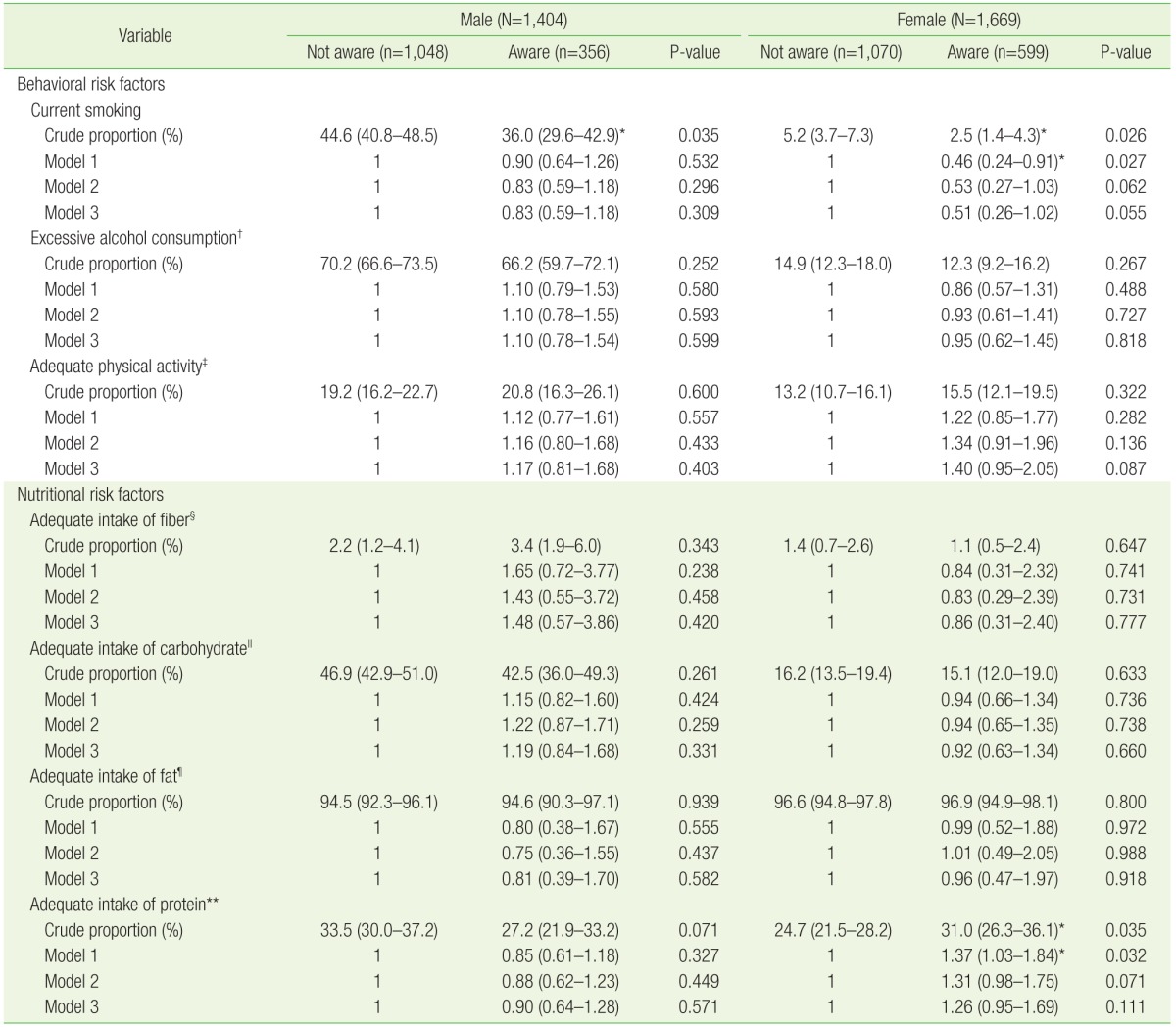
Values are presented as % (confidence interval) or adjusted odds ratio (95% confidence interval), weighted to the Korean standard population. Crude proportions with P-values were obtained from chi-square tests, and logistic regression analysis was performed to examine the association between awareness of dyslipidemia and each health behavior with the adjustments specified. Model 1: adjusted for age; model 2: adjusted for age and obesity (BMI ≥25 kg/m2), self-perceived health status, education, residential area, and household income; model 3: adjusted for age, obesity (BMI ≥25 kg/m2), self-perceived health status, education, residential area, household income, and diabetes mellitus.
BMI, body mass index.
*Statistically significant: P<0.05. †Excessive alcohol consumption: ≥3 standard drinks on ≥1 occasion in an average week. ‡Adequate physical activity: >150 minutes per week of moderate-intensity activity or >60 minutes per week of vigorous-intensity activity. §Adequate intake of fiber: ≥25 g/d. ∥Adequate intake of carbohydrate: <65% of total calories per day. ¶Adequate intake of fat: <30% of total calories per day. **Adequate intake of protein: ≥15% of total calories per day.
- TOOLS






